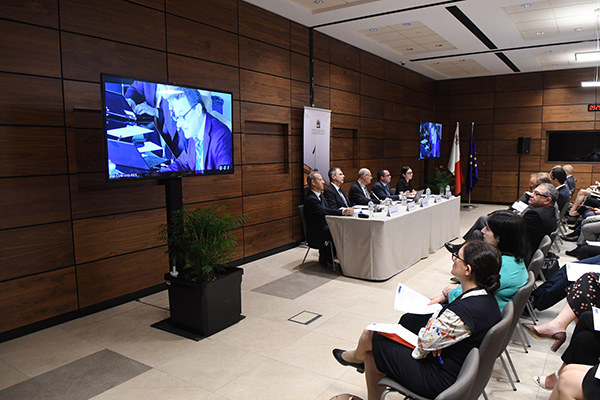Joint CBM/BdI Seminar on ‘Big data and machine learning technologies in a Central Bank environment’
On the 11 June 2019 the Central Bank of Malta (CBM) and the Banca d’Italia (BdI) jointly organised a half-day seminar entitled ‘Big data and machine learning technologies in a central bank environment’ at the CBM’s Laparelli Building in Valletta, Malta. The CBM’s panel of speakers comprised Oliver Bonello (Deputy Governor – Financial Stability), Alan Cassar (Chief Officer - Financial Stability) and Jesmond Pule’ (Head – Statistics Department). BdI officials present at the Seminar were Giuseppe Zingrillo (Head of IT Development Directorate) and Roberto Sabbatini (Deputy Head of the Statistical Data Collection and Processing Directorate). BdI officials who linked remotely through videoconference included Luigi Cannari (Deputy Director General of the Directorate for Economics, Statistics and Research), Grazia Marcese (Head of the Statistical Data Collection and Processing Directorate). Three CBM(1) and seven(2) BdI speakers delivered presentations on related topics.
Mr Bonello opened the Seminar by saying that “apart from being a core function in itself, the processing of data and statistics supports also other very important functions in a central bank…ever-changing demand and dynamics in data management and analytics, in turn, require robust, fit-for purpose infrastructures to keep delivering. The BdI/CBM set-up in the area of data management is not a mere service provider/client relationship governed by a rigid contract. Indeed, it represents an effective model of collaboration and partnership. A true example of how central banks within the ECSB could cooperate together…hence ensuring long-term cooperation and collaboration with potential to extend beyond the area of statistics and information management. The Seminar was an example of how such relationships branch out in other areas of mutual interest…Both central banks are on the same wavelength on the importance of big data and machine learning and how these are already shaping their environment. The introduction of machine learning in statistical processing, modelling and computational analyses, including approaches such as artificial neural networks, tree-based models and different clustering techniques have become relevant for central banking policy, regulation and economic modelling more widely”. Mr Bonello concluded by thanking the BdI officials who shared their experience with the CBM.
In their opening speech entitled ‘Organisational structure to handle big data and machine learning in a central bank environment Banca d’Italia experience: Business and IT perspectives’, Luigi Cannari and Giuseppe Zingrillo claimed that the BdI has already organised itself, by creating an internal Network to oversee the BdI’s operations with regards to big data and machine learning. The BdI is also promoting the idea that such coordination should also be undertaken at the European level to standardise and to reap the benefits of so many related activities which are currently fragmented.
The Seminar attracted around one hundred participants from the CBM, the Malta Financial Services Authority, the Maltese National Statistics Office and the University of Malta.
Further information on the Seminar can be found here.
__________________________________


